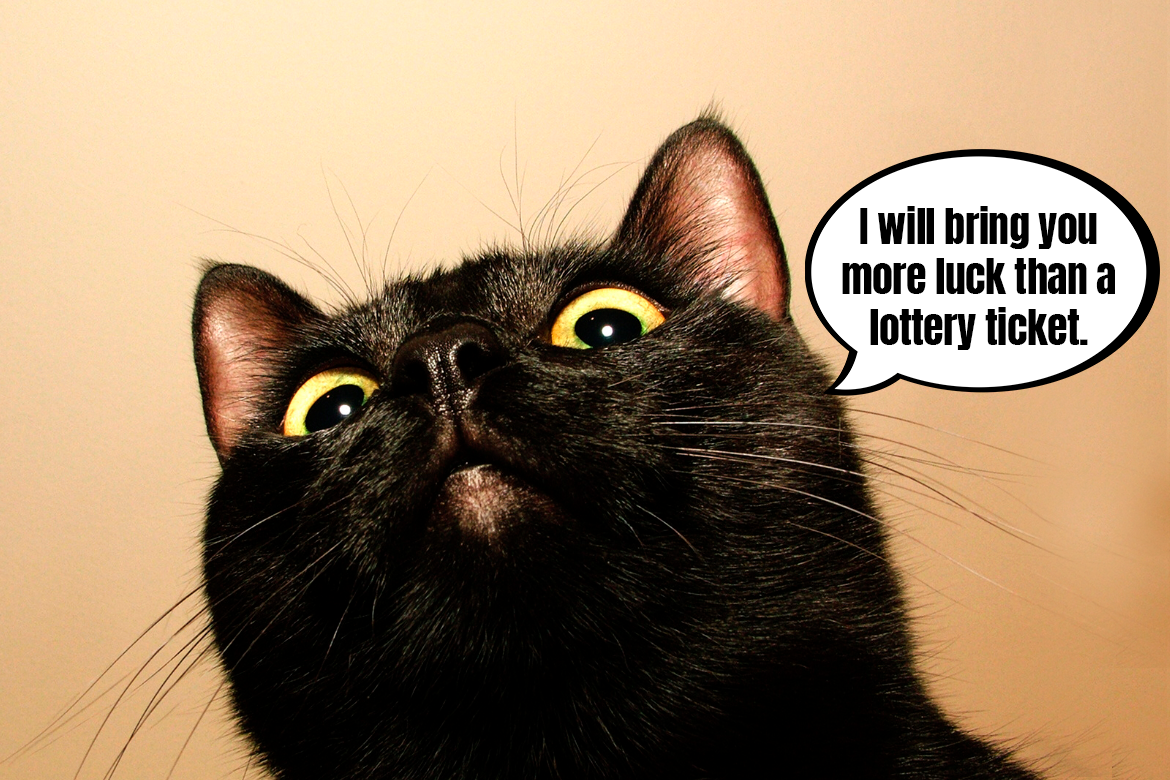Who hasn’t heard at least one harmful cat stereotype ever, be the first to throw a snack! We know that you – our dear fabCats, can easily distinguish a blant myth from facts and truths about cat existence. We also know, however, that cats have been given many labels throughout the years and no self-respecting, feisty kitten would agree with them. Today, with the help of your fabCatstic comments on Instagram, Facebook and Twitter, we’re debunking stereotypes that stuck out the most for us and you. Fasten your seatbelts and hold on tight – on the road to the secret cat dimension, serious bumps await.
The classic: a cat always lands on four paws
So often repeated, so untrue. Saying that a cat always lands on four paws is a classic myth. Cats do actually have an instinct to turn when falling, paws down, and keep them close or spread to slow down the falling speed. Everything happens in a very short moment, however, and with limited reaction time. Some falls can end too soon (e.g. with landing on a bush or the neighbours balcony), other are too painful even when landed on the proverbial four paws. There’s just one conclusion – securing your home so that the furry friends are not able to jump or fall from dangerous heights is a crucial element of setting up a cat space.
Cats don’t get attached to people, but to the place
This stereotype came up in your comments more than once and we certainly know why – in the non-cat community as well as, still, among some cat Carers, there’s a belief that cats are only getting attached to a place and every change of their environment is extremely difficult for them. It is true that moves, house renovations, travelling or even changing up the furniture setup in the house might be stressful to cats. After all, they are territorial creatures and they need to feel secure in their environment. It’s not true, however, that they are not attached to their hoomans! For a cat it’s much easier to move to a new home with their loving Carers than staying in the same old house on their own or with completely new, strange people.
An exception to this rule would be short-term weekend or holiday escapades – if your kitties don’t like travelling, leaving them at home for 2-3 days with a cat nanny is less stressful than driving for hundreds of miles in a packed car and getting settled in a new place just to leave it a few days later.
We also need to add here that for cats, getting close to hoomans is a very specific form of love and it isn’t solely grounded in the fact that people give food and therefore cats come to them for food. Cats are able to love and appreciate their Carers and within their family they will always find that one person who they form a tighter bond with. Does that sound like the personality of a soulless, cat individualist?
Cats are aggressive and can attack people
This myth comes probably from one of the most common problems that cat Carers face – bored cats attacking their hands and feet. The behaviour is not, however, a proof of cats being aggressive towards humans – the problem here is usually a cat not being taught the proper playing techniques. Every furry companion, even on their most lazy days, have it in their nature to hunt. In a home environment, cats fulfill their hunting needs by playing and doing the entire hunting cycle with their humans and toys. If we use our own hands or feet to play with the cat, they will see them as a great attack target. What’s more, cats quickly realise that attacking feet is bothering their Carer and can use it as a quick way to get their attention.
The proper techniques of playing with a wand, a string, a ball or a kicker should be practised from the early kitten stages. Let the hands be only used for petting and feel for walking above the cat spilled in the middle of the floor. 
Small kids can become a cat’s prey
Staying on the topic of aggressive behaviour, our attention was drawn to another interesting and completely false myth. Some people seem to believe that cats are a dangerous pet for a home with infants, because they can attack a small child who moves their hands around in the crib. Nothing of the kind! Even cats with a strong hunting instinct choose a prey item that they are realistically able to catch. Humans, even the tiny ones, are not an attractive target or a good toy. Children are completely safe around a cat, but it’s worth mentioning that as they grow up, small humans should be taught how to properly care for their kitten. Bugging them, pulling on their fur and tail or playing with hands can start some behavioral problems and cause unwanted attacks.
Cats are self-reliant and don’t need to be taken care of
We hear a lot about cats being independent. But are they actually the pets whose needs, even compared to dogs, are minimal? Definitely not! Cats don’t obviously need to be walked multiple times a day, regardless of the season, weather or the Carers mood. But they do need a regularly cleaned litter box, fur groomed, bowls filled with quality food, some quality toys and a space to rest and scratch. They also need to be played with, fulfilling their full hunting cycle. Cat’s needs are different to those of a dog, but we shouldn’t make them seem less important. Despite the often repeated opinion, cats are definitely not pets for those who leave their home for an entire day. To be fully happy cats require human attention and companionship. So let’s bury this harmful myth under a thick layer of cat litter, once and for all.
Feeding cats is easy
On the back of the previous myth we’ve stumbled upon another, not so accurate opinion about cats. Feeding them is easy and cats, just like a dog, will eat anything that pops up in their bowl? We’re sure that every fabCat burst in laughter right now, looking with compassion at the furry friend napping beside them with their very specific dietary needs. Cats are not walking “garbage cans” that eat every portion of food they come across – their obligate carnivores whose diet should consist of meat only, not of dinner leftovers. What’s more, the optimal feeding schedule is multiple small portions throughout the day. You can learn more about feeding cats in one of our older blog posts:
Cats are stinky creatures
The litter box is not a favorite sight in a cat Carer’s house, but it definitely shouldn’t be the reason for a myth about cats being stinky. The truth is its complete opposite and cats are in fact very clean beings who value their personal hygiene a lot. The unpleasant smells are usually caused by lack of proper grooming and systematicity from the Carers – the litter box should be cleaned out regularly, even a few times a day if there’s more cats in the house. We also need to remember that the smell of cat droppings depends on multiple factors – the cat’s diet (the better the food, the less smelly the poop), their health issues and illnesses, as well as being neutered. Cats and kittens who were not castrated can mark their territory, leaving behind an unpleasant smell, not only around the litter box.
Spite is in cats’ nature
We have to admit that, looking through the entire arsenal of cat myths, we’re shocked how many of them paint quite a negative picture of our cat companions. Among the worst ones is the misconception that cats are mean. Nothing of that sort! Cats, just like many other animals, are not showing emotions like this and are not driven by anger, jealousy or the need to make our lives miserable. Their actions may be disturbed by some behavioral or health issues (or combination of both), but those are problems that require working with behaviorists and veterinarians. It’s definitely not worth it to punish a cat for peeing in your shoes, meowing while you work or catching your ankles with their claws – it’s never a sign of a cat’s spite.
Cat-human communication does not exist
The myth of cats being spiteful may be closely related to another one, equally as an untrue stereotype that cats can’t communicate with people. Many studies around cat behavior show that our furry companions are very good at reading our expressions and behaviors and have worked out some communication methods, like meowing (which they don’t use to communicate with other cats), rubbing, purring and taking a particular stance to tell us what they need. The problem here might be on the Carers’ side – the cat language should be treated as any other foreign language and studied from the basics. It’s not enough to have a cat at home to understand all their signals right away.
Cats can’t learn
To finish things off we have a myth which has been debunked in the cat world quite recently. It’s all about cats’ ability to learn certain behaviour – not just tricks performed for treats, but also some actions in their everyday lives. Cats are quite the comprehensive creatures, able to think logically and connect some facts together. They can be taught to give a paw, high five and jump through obstacles, but also (which is very important for cat Guardians) to get their teeth brushed, be groomed or use the travel carrier. By working with treats and a clicker for a few weeks or months we can teach a cat a lot. Their training will be slightly different to the expectations we have for dogs. We can’t, however, assume up front that cats are not able to learn anything and always do only things they feel like doing.
Toast for those who stuck around with us to the end! Which of the myths were the most shocking to you, dear fabCats? Or maybe you haven’t heard some of them before? We’ll be waiting in the comments for your stories and maybe more suggestions of myths worth debunking. Take care and remember – it’s our, the fabCat Guardian’s responsibility to debunk cat myths and stereotypes in our close environment. Good luck!




